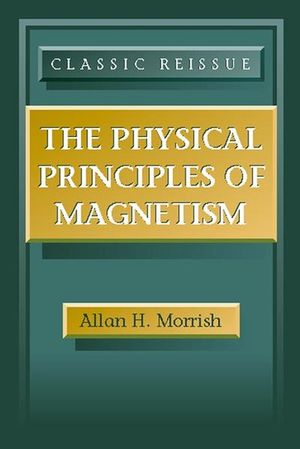The Physical Principles of MagnetismISBN: 978-0-7803-6029-7
Hardcover
700 pages
January 2001, Wiley-IEEE Press
 This is a Print-on-Demand title. It will be printed specifically to fill your order. Please allow an additional 10-15 days delivery time. The book is not returnable.
|
||||||
1. Historical.
2. The Magnetic field Vector H.
3. The Magnetization Vector M.
4. Magnetic Induction, the Vector B.
5. The Demagnetization Factor D.
6. Energy of Interaction.
7. Magnetic Effects of Currents. The Magnetic Shell. Faraday's Law.
8. Maxwell's and Lorentz's Equations.
9. The Magnetic Circuit.
10. Dipole in a Uniform Field.
2. Diamagnetic and Paramagnetic Susceptibilities.
1. Introduction.
2. Review of Quantum Mechanical and Other Results.
Diamagnetism.
3. The Langevin Formula for Diamagnetic Susceptibility.
4. Susceptibility of Atoms and Ions.
5. Susceptibility of Molecules.
Paramagnetism.
6. Curie's Law.
7. Theoretical Derivations of Curie's Law.
8. Quantum Mechanical Treatment.
9. Susceptibility of Quasi-free Ions: the Rare Earths.
10. The Effect of the Crystalline Field.
11. The Iron Group Salts.
12. Covalent Binding and the 3d, 4d, 5d, and 5f-6d Transition Groups.
13. Saturation in Paramagnetic Substances.
14. Paramagnetic Molecules.
15. Paramagnetic Susceptibility of the Nucleus.
3. Thermal, Relaxation, and Resonance Phenomena in Paramagnetic Materials.
1. Introduction.
Thermal Phenomena.
2. Summary of Thermodynamic Relationships.
3. The Magnetocaloric Effect: The Production and Measurement of Low Temperatures.
Paramagnetic Relaxation.
4. The Susceptibility in an Alternating Magnetic Field.
5. Spin-Lattice Relaxation.
6. Spin-spin Relaxation.
Paramagnetic Resonance.
7. Conditions for Paramagnetic Resonance.
8. Line Widths: the Effect of Damping.
9. Fine and Hyperfine Structure: the Spin-Hamiltonian.
10. The Spectra of the Transition Group Ions.
The 3d group ions.
Covalent binding and the 3d, Ad, 5d, and 5f-6d groups.
4/rare earth ions in salts.
Transition ions in various host lattices.
11. The Spectra of Paramagnetic Molecules and Other Systems.
Paramagnetic gases.
Free radicals.
Donors and acceptors in semiconductors.
Traps, F-centers, etc.
Defects from radiation damage.
12. The Three-Level Maser and Laser.
4. Nuclear Magnetic Resonance.
1. Introduction.
2. Line Shapes and Widths.
3. Resonance in Nonmetallic Solids.
4. The Influence of Nuclear Motion on Line Widths and Relaxations.
5. The Chemical Shift: Fine Structure.
6. Transient Effects: the Spin-Echo Method.
7. Negative Temperatures.
8. Quadrupole Effects and Resonance.
9. Nuclear Orientation.
10. Double Resonance.
11. Beam Methods.
5. The Magnetic Properties of an Electron Gas.
1. Statistical and Thermodynamic Functions for an Electron Gas.
2. The Spin Paramagnetism of the Electron Gas.
3. The Diamagnetism of the Electron Gas.
4. Comparison of Susceptibility Theory with Experiment.
5. The De Haas-Van Alphen Effect.
6. Galvanomagnetic, Thermomagnetic, and Magnetoacoustic Effects.
7. Electron Spin Resonance in Metals.
8. Cyclotron Resonance.
9. Nuclear Magnetic Resonance in Metals.
10. Some Magnetic Properties of Superconductors.
6. Ferromagnetism.
1. Introduction.
2. The Classical Molecular Field Theory and Comparison with Experiment.
The spontaneous magnetization region.
The paramagnetic region.
Thermal effects.
3. The Exchange Interaction.
4. The Series Expansion Method.
5. The Bethe-Peierls-Weiss Method.
6. Spin Waves.
7. Band Model Theories of Ferromagnetism.
8. Ferromagnetic Metals and Alloys.
9. Crystalline Anisotropy.
10. Magnetoelastic Effects.
7. The Magnetization of Ferromagnetic Materials.
1. Introduction.
2. Single-Domain Particles.
Critical size.
Hysteresis loops.
Incoherent rotations.
Some experimental results.
Other effects.
3. Superparamagnetic Particles.
4. Permanent Magnet Materials.
5. Domain Walls.
6. Domain Structure.
7. The Analysis of the Magnetization Curves of Bulk Material.
Domain wall movements.
Coercive force.
Initial permeability.
Picture frame specimens.
The approach to saturation.
Remanence.
Nucleation of domains: whiskers.
Barkhausen effect.
Preisach-type models.
External stresses.
Minor hysteresis loops.
8. Thermal Effects Associated with the Hysteresis Loop.
9. Soft Magnetic Materials.
10. Time Effects.
11. Thin Films.
8. Antiferromagnetism.
1. Introduction.
2. Neutron Diffraction Studies.
3. Molecular Field Theory of Antiferromagnetism.
Behavior above the Neel temperature.
The Neel temperature.
Susceptibility below the Neel temperature.
Sublattice arrangements.
The paramagnetic-antiferromagnetic transition in the presence of an applied magnetic field.
Thermal effects.
4. Some Experimental Results for Antiferromagnetic Compounds.
5. The Indirect Exchange Interaction.
6. More Advanced Theories of Antiferromagnetism.
The series expansion method.
The Bethe-Peierls-Weiss method.
Spin waves.
7. Crystalline Anisotropy: Spin Flopping.
8. Metals and Alloys.
9. Canted Spin Arrangements.
10. Domains in Antiferromagnetic Materials.
11. Interfacial Exchange Anisotropy.
9. Ferrimagnetism.
1. Introduction.
2. The Molecular Field Theory of Ferrimagnetism.
Paramagnetic region.
The ferrimagnetic Neel temperature.
Spontaneous magnetization.
Extension to include additional molecular fields.
Triangular and other spin arrangements.
Three sublattice systems.
Ferromagnetic interaction between sublattices.
3. Spinels.
4. Garnets.
5. Other Ferrimagnetic Materials.
6. Some Quantum Mechanical Results.
7. Soft Ferrimagnetic Materials.
8. Some Topics in Geophysics.
10. Resonance in Strongly Coupled Dipole Systems.
1. Introduction.
2. Magnetomechanical Effects.
3. Ferromagnetic Resonance.
4. Energy Formulation of the Equations of Motion.
5. Resonance in Ferromagnetic Metals and Alloys.
6. Ferromagnetic Resonance of Poor Conductors.
7. Magnetostatic Modes.
8. Relaxation Processes.
Relaxation via spin waves in insulators.
Relaxation via spin waves in conductors.
Fast relaxation via paramagnetic ions.
Slow relaxation via electron redistribution.
9. Nonlinear Effects.
10. Spin-Wave Spectra of Thin Films.
11. Electromagnetic Wave Propagation in Gyromagnetic Media.
12. Resonance in Unsaturated Samples.
13. Ferrimagnetic Resonance.
14. Antiferromagnetic Resonance.
15. Nuclear Magnetic Resonance in Ordered Magnetic Materials.
16. The Mossbauer Effect.
Appendix I. Systems of Units.
Appendix II. Demagnetization Factors for Ellipsoids of Revolution.
Appendix III. Periodic Table of the Elements.
Appendix IV. Numerical Values for Some Important Physical Constants.
Author Index.
Subject Index.



